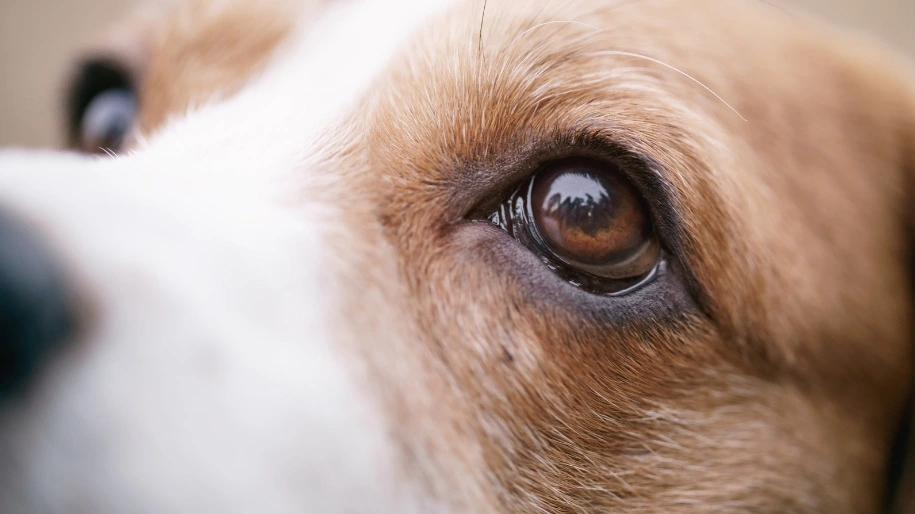PET CARE
It’s essential that your pet has clear vision and healthy eyes so they can connect with the world around them. Here are a few ways you can stay on top of your pet’s eye health next year:
Examine Your Pet’s Eyes At Home
Take a look at your pet’s eyes every day to make sure they’re healthy.
Your dog or cat should have eyes that are moist, bright, and clear, with no redness in the whites of the eyes. Any dirt, discharge, or swelling could be cause for concern. Speak with your vet if you have any questions at all about your pet’s eye health. Eye diseases can be dangerous, so it’s better to be safe than sorry.
Clean Your Pet’s Eyes
You can carefully clean your pet’s eyes at home to stave off any risk of infection.
Use a soft, damp washcloth (with nothing on it except water) to gently clean around your pet's eyes and remove any dirt. Don’t wipe your pet’s eyeball — just clean the area around the eye, and remember to not use any soap or shampoo. Alternatively, you can use damp cotton balls instead of a washcloth. For dogs, you can also clean their face and eyes when you’re giving them a bath.
Learn About Common Eye Diseases in Pets
According to Only Natural Pet, the following eye conditions or disorders are common in dogs:
- Conjunctivitis (pinkeye): Symptoms of this condition can include redness, discomfort, excessive tear production, and discharge.
- Glaucoma: Glaucoma often causes dilated pupils, cloudy eyes, and discomfort. It can also cause blindness if it’s not caught early.
- Cherry eye: This condition affects a dog’s third eyelid, causing the red gland to prolapse over the white of the eye.
- Cataracts: Cataracts are cloudy spots that appear on the lens of your dog’s eye. They can happen in dogs of any age.
These eye conditions and disorders are common in cats:
- Corneal ulcers: Especially common in outdoor cats, corneal ulcers often cause inflammation, itching, redness, and discharge and can be serious.
- Uveitis: Uveitis (inflammation of the vascular tissues) can have one of a few different causes. Symptoms include tearing, redness, discharge, swelling, and poor vision.
- Glaucoma: Eyes that look red, cloudy, swollen, and/or sore may signal glaucoma.
Familiarize yourself with the signs and symptoms of these and other eye disorders. Once familiarized, you will then be able to decide whether you need to speak with your vet if you ever notice anything amiss with your pet’s eyes.
It’s also important to note that some breeds are more at-risk for poor eye health than others. For example, Persian cats have very large eyes, making them more prone to infections. And collies and other herding dogs commonly have eye anomalies. Learning more about your pet’s breed and DNA can help you get a feel for any potential eye conditions they might develop down the road.
Provide Adequate Hydration and Nutrition
Hydration and nutrition are important to keep every part of the body running smoothly, including the eyes! You don’t want your pet’s eyes to get dry, so make sure to provide plenty of fresh water every day.
Speak with your vet about the best diet for eye health, too. For dogs, you might consider adding eye superfoods such as blueberries, broccoli, and carrots to their kibble if your vet recommends it and says it is safe to do so. Always speak with your vet prior to changing your dog or cats food and/or before adding new food into your pet's diet.
Schedule Eye Examinations
Whether you’ve noticed symptoms of an eye disease or not, it’s important to make sure a qualified veterinarian is looking at your pet’s eyes on a regular basis. Just like you have regular checkups at the eye doctor, your pet needs regular eye checkups, too!
During this time, your vet can get an up-close look at your pet’s eyes to make sure nothing is wrong. You’ll also be able to bring up any questions or concerns that you might have regarding your pets overall health.
Does Your Pet Need an Eye Exam? Pet Insurance Can Help
The cost to diagnose, treat, and maintain certain eye conditions can put a dent in your budget, especially if you're not prepared. So if your pet needs to go to the vet for an eye exam or see a veterinary ophthalmologist for treatment, MetLife Pet Insurance may be able to help. With coverage for new accidents and illnesses, you could get money back and help your pet feel better. Start your pet insurance journey today with a free, personalized quote.

